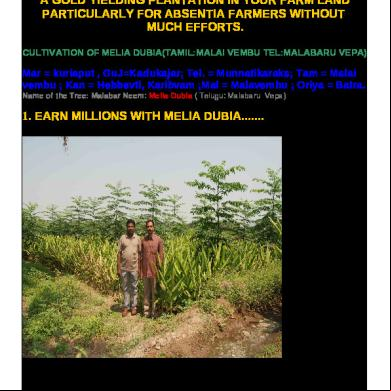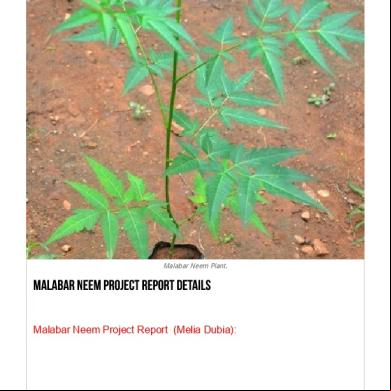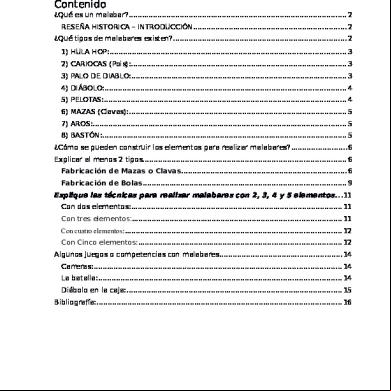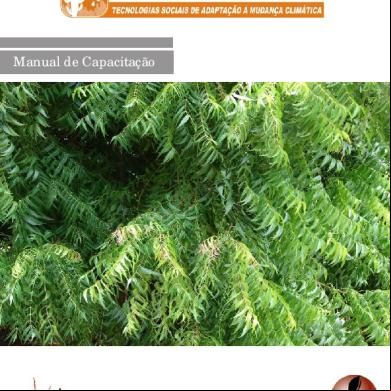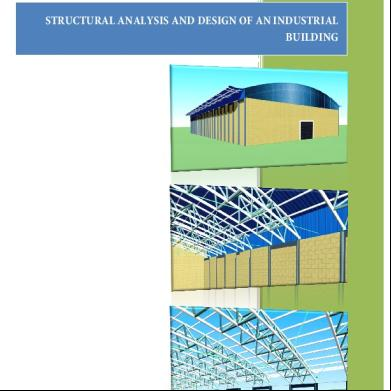Raising Malabar Neem (melia Dubia) 4g4j17
This document was ed by and they confirmed that they have the permission to share it. If you are author or own the copyright of this book, please report to us by using this report form. Report 3b7i
Overview 3e4r5l
& View Raising Malabar Neem (melia Dubia) as PDF for free.
More details w3441
- Words: 2,297
- Pages: 7
4/28/2017
Innovations for raising Malabar Neem (Melia dubia) in Tamil Nadu, India | TECA English
GO TO
BOTTOM Technologies and practices for small agricultural producers
Home > Technologies > Innovations for raising Malabar Neem (Melia dubia) in Tamil Nadu, India >
Innovations for raising Malabar Neem (Melia dubia) in Tamil Nadu, India Search the whole site
FAO Home TECA Home Search & Browse Exchange Groups
Summary This practice focuses on facilitating the nursery germination and plantation of the “Malabar Neem” (Melia dubia), which is locally known as “Malaivembu”. The tree is found in forest plantations in India and is a fast growing tree crop with up to 20 meters height. It produces greater biomass in relatively shorter period. As the seed has a tough seed coat, that does not allow water to penetrate easily, the germination becomes rather difficult. By softening the coat of the seed, the germination difficulties can be solved and enable fast germination. This practice presents valuable costeffective methods for smallscale farmers to raise their own Melia dubia seedlings and establish a plantation independently from seedling suppliers.
Description
FAQ
What is Melia dubia? Malabar Neem (Melia dubia) is a tropical deciduous tree that grows up to 20 meters height. The tree is one of the fast growing species under irrigated conditions. It can be harvested early i.e. within 4 years for plywood production or for paper industry. Long term harvest beyond 715 years ensures good quality timber with advancing years of maturity that can be used for construction. The softwood trees are suitable for plywood production and paper pulp industry, which make them the favorites for farmers to cultivate them in Agroforestry systems along with vegetables, groundnut and banana. It will grow best in welldrained fertile soils with ample moisture supply. The tree will grow erect with a single trunk up to 3 meter (10 ft.) height or more without branching when pruning side shoots or nipping the nodal buds is done. A famer can earn profit of about Rs. 90,000 by growing 1 acre of land (0.4 ha) area with about 1000 seedlings planted. This corresponds to a yield of 30 tons of wood per acre/75 per hectare respectively). Intercrops, like groundnut, green gram or black gram can be raised within the interspace in the first year of planting. Banana can be included as a crop, if Melia dubia is planted for timber purpose with wider spacing of 56 meters between rows of the planted trees. Intercropping the tree with other tree species is not advisable as it could slow down the growth or the erectness of the Malabar Neem, and lead to bending.
Melia dubia is often grown along with other trees such as Teak, Nutmeg and coconut trees to fill the inter space between trees in a garden. Melia dubia is usually planted within large gaps in the existing garden where other tree species like coconut and teak are cultivated to utilize the empty space advantageously. Intercrops, like groundnut, green gram and black gram could be raised within the inter space in the first year of planting.
http://teca.fao.org/read/8767
1/7
4/28/2017
Innovations for raising Malabar Neem (Melia dubia) in Tamil Nadu, India | TECA
GO TO BOTTOM
Main steps of preparation of Melia dubia seedlings 1. Loosening the hard seed coat The Melia dubia seeds have a tough coat that hampers water penetration and germination accordingly. Here it is described, how to loosen the seed coat to facilitate germination: The first step is to loosen the seed coat. For this process, the seed should be partially rotten or decomposed by placing the seeds in a moistened cow dung heap. For the heap, you can collect dried cow dung and sprinkle it with water. Then keep it under shade for about 2 months. Take about 5 kg of dried cow dung for the treatment of about 2 kg of seeds. By testing the softness of the peel, one can find out the exact time for peeling the external coat of the seeds. Usually, it is roughly about 2 months. When the outer seed coat becomes soft, the coat can be removed and the inner hard layer can be peeled by making three shallow cuts longitudinally using a knife to take out the kernels. The seeds look similar to sunflower seeds. In each seed 23 kernels can be extracted. This should be done very carefully, so that there isn’t any slight damage to kernels. The kernels should then be dibbled in a seed bed, specially made for husbandry.
2. Preparation of the seedbed and dibbling of the seed Melia dubia will grow well in fertile soils with sufficient moisture supply. Prepare the seedbed by mixing red soil with fine sand (In the case of Tamil Nadu). Dibble the seed kernels evenly and sprinkle water twice a day, in the morning and evening uniformly. Cover the seedbed with polyspread sheet as to maintain the optimum temperature and moisture for the seed planted inside. An example of how this socalled mist chamber could look like can be found below.
3. Germination and seedling transplantation
http://teca.fao.org/read/8767
2/7
4/28/2017
Innovations for raising Malabar Neem (Melia dubia) in Tamil Nadu, India | TECA The seeds will start to germinate in about 3 months’ time but only 30% of them will germinate completely (natural germination rate). When the seedlings have grown to twoleaf stage (i.e. plant physiological stage when the 2nd leafs of the seedling have emerged completely), they are uprooted carefully without damaging the rootsystem and planted into polythene bags of 15 x 8 cm dimension. GO TO The bags are made out of thermoplastic material and are filled with a mix of red soil, fine sand and organic manure (compare figure BOTTOM
1).
Whenever there is rain, the excess water should be drained off the bags. Otherwise, the young seedlings in the polythene bags are likely to rot, due to excessive moisture in the root zone. The seedlings will grow up to 60 cm height (2 ft.) in another 30 days. At that height, they are ready to be planted in the main field.
4. Plant health measures and irrigation To avoid the rotting of the young seedlings in the polythene bags drain off excess water. In case there is a sprinkler system available, it should consists of installed sprinkler tubes that will on just above the seedlingbags. The entire seedlings can also be placed in a polythene sheet covered chamber of dimension 3 x 3 x 3 meter (10’x10’x10’ ft.), in order to prevent rainwater to enter the bags.
Planting Melia dubia seedlings in the main field
First dig out a pit of 60 cm cube (2 ft. cube). Leave space either 2 x 2 meter (10 x 10 ft.), 4,5 x 4,5 meter (15 x 15 ft.) or 6 x 6 meter (20 x 20 ft.) between the pits (1000 seedlings per 0.4 ha for paper industry or 110 seedlings for timber purpose). Dug pits manually by using a handhoe or mechanically by using an augur mounted on a tractor. Fill the pits with red soil, fine sand and well decomposed manure. Plant the seedlings at the center upright and make sure to press the soil well around the seedling base.
Irrigation Follow planting by light irrigation on the 3rd day after planting. This could be done through drip irrigation via installation of drip pipes (compare figure 8). Thereafter, apply light irrigation once in 7 to 10 days (for a guideline how to design and evaluate surface irrigation systems, follow http://www.fao.org/docrep/t0231e/t0231e00.htm#Contents). The seedlings will grow up between 1. 2 meter (4 ft.) to 1. 8 m (6 ft.) height in another 4 months. During rainy season, try to prevent the rain water to stagnate around the seedlings. Drain off excess water effectively. Planting seedlings at the end of the rainy season or summer is advisable to avoid stagnation of rainwater in the pits.
http://teca.fao.org/read/8767
3/7
4/28/2017
Innovations for raising Malabar Neem (Melia dubia) in Tamil Nadu, India | TECA
GO TO BOTTOM
Pruning Prune the branches when the seedlings attain 2 meter (6 ft.) height, periodically at 15 days intervals so that one straight trunk up to 10 meter (30 ft.) height can be achieved. Prune the side shoots or nip the nodal buddings grownin between the main trunk and the side branches as shown in the pictures below.
Harvesting products from Melia dubia After 7 to 12 years the trees offer good timber, which can be cut and sold profitably. Nowadays, for quick return, famers usually cut the trees at 3 years of age for selling the wood to paper industries. It is estimated to obtain around 75 tons/ha of land (30 tons/acre). The paper industry procures the wood at Rs. 4500/ton; usually, famers engage laborers and pay Rs.1500/ton of wood as cutting and lorry transport charges to the site of the pulp industry on a contract basis. Cut the trees just above the ground level. Then, there will be many side suckers emerging from the basal region of the stem. Allowing only one sucker from the tree clump is the usual practice (leaving the plants) as ratoon crop[1]. Perennial crops avoid costs for the preparation of the field and additional planting. Continue with the irrigation. Ratoons will grow fast and attain sufficient thickness within short time compared to freshly planted seedlings. Allow three successive ratoons for optimum production with maximum returns without affecting the productivity or profitability of tree farming. Leave only one sucker and remove other suckers in one tree clump. Nowadays due to shortage of labor or high labor costs, tree farming with Melia dubia is more profitable compared to raising annual crops under intensive systems as experienced by the innovating farmer in Kallipatti village in the Erode district, Tamil Nadu.
[1]Ratooning (from Spanish retoño, "sprout") is a method of harvesting a crop which leaves the roots and the lower parts of the plant uncut to give the ratoon or the stubble crop. The main benefit of ratooning is that the crop matures earlier in the season. Ratooning can
http://teca.fao.org/read/8767
4/7
4/28/2017
Innovations for raising Malabar Neem (Melia dubia) in Tamil Nadu, India | TECA also decrease the cost of preparing the field and planting. This method cannot be used endlessly as the yield of the ratoon crop decreases after each cycle. Ratooning is most often used with crops which are known to give a steady yield for three years under most conditions (Wikipedia)
Validation
GO TO BOTTOM
This practice was developed and applied in a local context by a farmer in Kallipatti village, Erode District of Tamil Nadu in southern India. By seeing the profitable cultivation of “Malai Vembu” trees, the farmer started raising 60,000 trees in her field. This had a multiplying effect to the neighboring farmers by which they started to plant the tree crop within their fields. She initially raised 1000 seedlings and supplied them to the neighboring farmers. Even a TVchannel has covered the farmer’s innovation and many people came forward for supply orders of 50,000 seedlings in total. So far, she has supplied 12,000 seedlings and has always been busy in raising and supplying seedlings to other farmers according to their demand and her convenience. Recently, tissue cultured seedlings are being distributed by paper industries and therefore the demand for conventional type seedlings has decreased tremendously. The local innovation has had a significant outreach to other farmers of the area: Now there are more than 200 farmers in and around Kallipatti village of the Erode District, which plant and market the tree crop. Also, farmers in neighboring districts, like e.g. Dindugul, Coimbatore, have been growing this tree as commercial crop for more than 6 years now. By growing in one acre (0.4 ha) of land, a farmer can harvests up to 30 tons in 3 years, thus earning an income of Rs. 4, 500 per ton; cutting charges and lorry transport charges cost Rs.1, 500 per ton. Thus it is possible to earn a net profit of Rs. 90, 000 from one acre. This corresponds to Rs. 225, 000 per hectare.
Images
Further reading A video, explaining the different techniques in Tamil language is available: https://www.youtube.com/watch?v=s2sOnXkjteE http://www.thehindu.com/scitech/agriculture/meliadubiatreeholdsprom... FAO Irrigation guidelines: http://www.fao.org/docrep/t0231e/t0231e00.htm#Contents
Keywords http://teca.fao.org/read/8767
5/7
4/28/2017
Innovations for raising Malabar Neem (Melia dubia) in Tamil Nadu, India | TECA Melia agroforestry nursery raising Seedling production seedling
GO TO BOTTOM
Category Forestry Natural Resources Management
Region South Asia
Countries India
Created date Mon, 13/06/2016 00:00
Source(s)
Sustainable Agriculture & Environmental Voluntary Action SEVA SEVA (Sustainable Agriculture & Environmental Voluntary Action) is an Indian NGO, located in Tamil Nadu in the southern part of India. It is a ed society under the 'Society Registration Act' of Tamil Nadu (RegNo.136/92). The NGO has been constantly involved in various activities, as there are: the documentation and dissemination of indigenous knowledge and grassroots innovations; the conservation of local livestock breeds in Tamil Nadu State; promoting self help groups with farmers, livestock keepers and grassroots innovators; SEVA has been publishing a local newsletter in Tamil language called “Num Vali Velanmai” for communicating indigenous knowledge, organic practices, innovations in agriculture, animal husbandry and natural resource management. The NGO has been a member of the “Honey Bee Network” and it collaborates with organizations and volunteers in other language regions of the country for the purpose of knowledge networking. SEVA is the coordinator of the “LIFE Network” and attempts capacity building of livestock keepers and pastoralists towards the conservation of local livestock breeds in India.
http://teca.fao.org/read/8767
6/7
4/28/2017
Innovations for raising Malabar Neem (Melia dubia) in Tamil Nadu, India | TECA
GO TO BOTTOM
s: P. Vivekanandan person: [email protected] email: +914522380082 Telephone: http://www.sevango.in/ Web: India Country:
0
4
googleplus
0
4
© FAO 2017 About us
http://teca.fao.org/read/8767
Disclaimer
7/7
Innovations for raising Malabar Neem (Melia dubia) in Tamil Nadu, India | TECA English
GO TO
BOTTOM Technologies and practices for small agricultural producers
Home > Technologies > Innovations for raising Malabar Neem (Melia dubia) in Tamil Nadu, India >
Innovations for raising Malabar Neem (Melia dubia) in Tamil Nadu, India Search the whole site
FAO Home TECA Home Search & Browse Exchange Groups
Summary This practice focuses on facilitating the nursery germination and plantation of the “Malabar Neem” (Melia dubia), which is locally known as “Malaivembu”. The tree is found in forest plantations in India and is a fast growing tree crop with up to 20 meters height. It produces greater biomass in relatively shorter period. As the seed has a tough seed coat, that does not allow water to penetrate easily, the germination becomes rather difficult. By softening the coat of the seed, the germination difficulties can be solved and enable fast germination. This practice presents valuable costeffective methods for smallscale farmers to raise their own Melia dubia seedlings and establish a plantation independently from seedling suppliers.
Description
FAQ
What is Melia dubia? Malabar Neem (Melia dubia) is a tropical deciduous tree that grows up to 20 meters height. The tree is one of the fast growing species under irrigated conditions. It can be harvested early i.e. within 4 years for plywood production or for paper industry. Long term harvest beyond 715 years ensures good quality timber with advancing years of maturity that can be used for construction. The softwood trees are suitable for plywood production and paper pulp industry, which make them the favorites for farmers to cultivate them in Agroforestry systems along with vegetables, groundnut and banana. It will grow best in welldrained fertile soils with ample moisture supply. The tree will grow erect with a single trunk up to 3 meter (10 ft.) height or more without branching when pruning side shoots or nipping the nodal buds is done. A famer can earn profit of about Rs. 90,000 by growing 1 acre of land (0.4 ha) area with about 1000 seedlings planted. This corresponds to a yield of 30 tons of wood per acre/75 per hectare respectively). Intercrops, like groundnut, green gram or black gram can be raised within the interspace in the first year of planting. Banana can be included as a crop, if Melia dubia is planted for timber purpose with wider spacing of 56 meters between rows of the planted trees. Intercropping the tree with other tree species is not advisable as it could slow down the growth or the erectness of the Malabar Neem, and lead to bending.
Melia dubia is often grown along with other trees such as Teak, Nutmeg and coconut trees to fill the inter space between trees in a garden. Melia dubia is usually planted within large gaps in the existing garden where other tree species like coconut and teak are cultivated to utilize the empty space advantageously. Intercrops, like groundnut, green gram and black gram could be raised within the inter space in the first year of planting.
http://teca.fao.org/read/8767
1/7
4/28/2017
Innovations for raising Malabar Neem (Melia dubia) in Tamil Nadu, India | TECA
GO TO BOTTOM
Main steps of preparation of Melia dubia seedlings 1. Loosening the hard seed coat The Melia dubia seeds have a tough coat that hampers water penetration and germination accordingly. Here it is described, how to loosen the seed coat to facilitate germination: The first step is to loosen the seed coat. For this process, the seed should be partially rotten or decomposed by placing the seeds in a moistened cow dung heap. For the heap, you can collect dried cow dung and sprinkle it with water. Then keep it under shade for about 2 months. Take about 5 kg of dried cow dung for the treatment of about 2 kg of seeds. By testing the softness of the peel, one can find out the exact time for peeling the external coat of the seeds. Usually, it is roughly about 2 months. When the outer seed coat becomes soft, the coat can be removed and the inner hard layer can be peeled by making three shallow cuts longitudinally using a knife to take out the kernels. The seeds look similar to sunflower seeds. In each seed 23 kernels can be extracted. This should be done very carefully, so that there isn’t any slight damage to kernels. The kernels should then be dibbled in a seed bed, specially made for husbandry.
2. Preparation of the seedbed and dibbling of the seed Melia dubia will grow well in fertile soils with sufficient moisture supply. Prepare the seedbed by mixing red soil with fine sand (In the case of Tamil Nadu). Dibble the seed kernels evenly and sprinkle water twice a day, in the morning and evening uniformly. Cover the seedbed with polyspread sheet as to maintain the optimum temperature and moisture for the seed planted inside. An example of how this socalled mist chamber could look like can be found below.
3. Germination and seedling transplantation
http://teca.fao.org/read/8767
2/7
4/28/2017
Innovations for raising Malabar Neem (Melia dubia) in Tamil Nadu, India | TECA The seeds will start to germinate in about 3 months’ time but only 30% of them will germinate completely (natural germination rate). When the seedlings have grown to twoleaf stage (i.e. plant physiological stage when the 2nd leafs of the seedling have emerged completely), they are uprooted carefully without damaging the rootsystem and planted into polythene bags of 15 x 8 cm dimension. GO TO The bags are made out of thermoplastic material and are filled with a mix of red soil, fine sand and organic manure (compare figure BOTTOM
1).
Whenever there is rain, the excess water should be drained off the bags. Otherwise, the young seedlings in the polythene bags are likely to rot, due to excessive moisture in the root zone. The seedlings will grow up to 60 cm height (2 ft.) in another 30 days. At that height, they are ready to be planted in the main field.
4. Plant health measures and irrigation To avoid the rotting of the young seedlings in the polythene bags drain off excess water. In case there is a sprinkler system available, it should consists of installed sprinkler tubes that will on just above the seedlingbags. The entire seedlings can also be placed in a polythene sheet covered chamber of dimension 3 x 3 x 3 meter (10’x10’x10’ ft.), in order to prevent rainwater to enter the bags.
Planting Melia dubia seedlings in the main field
First dig out a pit of 60 cm cube (2 ft. cube). Leave space either 2 x 2 meter (10 x 10 ft.), 4,5 x 4,5 meter (15 x 15 ft.) or 6 x 6 meter (20 x 20 ft.) between the pits (1000 seedlings per 0.4 ha for paper industry or 110 seedlings for timber purpose). Dug pits manually by using a handhoe or mechanically by using an augur mounted on a tractor. Fill the pits with red soil, fine sand and well decomposed manure. Plant the seedlings at the center upright and make sure to press the soil well around the seedling base.
Irrigation Follow planting by light irrigation on the 3rd day after planting. This could be done through drip irrigation via installation of drip pipes (compare figure 8). Thereafter, apply light irrigation once in 7 to 10 days (for a guideline how to design and evaluate surface irrigation systems, follow http://www.fao.org/docrep/t0231e/t0231e00.htm#Contents). The seedlings will grow up between 1. 2 meter (4 ft.) to 1. 8 m (6 ft.) height in another 4 months. During rainy season, try to prevent the rain water to stagnate around the seedlings. Drain off excess water effectively. Planting seedlings at the end of the rainy season or summer is advisable to avoid stagnation of rainwater in the pits.
http://teca.fao.org/read/8767
3/7
4/28/2017
Innovations for raising Malabar Neem (Melia dubia) in Tamil Nadu, India | TECA
GO TO BOTTOM
Pruning Prune the branches when the seedlings attain 2 meter (6 ft.) height, periodically at 15 days intervals so that one straight trunk up to 10 meter (30 ft.) height can be achieved. Prune the side shoots or nip the nodal buddings grownin between the main trunk and the side branches as shown in the pictures below.
Harvesting products from Melia dubia After 7 to 12 years the trees offer good timber, which can be cut and sold profitably. Nowadays, for quick return, famers usually cut the trees at 3 years of age for selling the wood to paper industries. It is estimated to obtain around 75 tons/ha of land (30 tons/acre). The paper industry procures the wood at Rs. 4500/ton; usually, famers engage laborers and pay Rs.1500/ton of wood as cutting and lorry transport charges to the site of the pulp industry on a contract basis. Cut the trees just above the ground level. Then, there will be many side suckers emerging from the basal region of the stem. Allowing only one sucker from the tree clump is the usual practice (leaving the plants) as ratoon crop[1]. Perennial crops avoid costs for the preparation of the field and additional planting. Continue with the irrigation. Ratoons will grow fast and attain sufficient thickness within short time compared to freshly planted seedlings. Allow three successive ratoons for optimum production with maximum returns without affecting the productivity or profitability of tree farming. Leave only one sucker and remove other suckers in one tree clump. Nowadays due to shortage of labor or high labor costs, tree farming with Melia dubia is more profitable compared to raising annual crops under intensive systems as experienced by the innovating farmer in Kallipatti village in the Erode district, Tamil Nadu.
[1]Ratooning (from Spanish retoño, "sprout") is a method of harvesting a crop which leaves the roots and the lower parts of the plant uncut to give the ratoon or the stubble crop. The main benefit of ratooning is that the crop matures earlier in the season. Ratooning can
http://teca.fao.org/read/8767
4/7
4/28/2017
Innovations for raising Malabar Neem (Melia dubia) in Tamil Nadu, India | TECA also decrease the cost of preparing the field and planting. This method cannot be used endlessly as the yield of the ratoon crop decreases after each cycle. Ratooning is most often used with crops which are known to give a steady yield for three years under most conditions (Wikipedia)
Validation
GO TO BOTTOM
This practice was developed and applied in a local context by a farmer in Kallipatti village, Erode District of Tamil Nadu in southern India. By seeing the profitable cultivation of “Malai Vembu” trees, the farmer started raising 60,000 trees in her field. This had a multiplying effect to the neighboring farmers by which they started to plant the tree crop within their fields. She initially raised 1000 seedlings and supplied them to the neighboring farmers. Even a TVchannel has covered the farmer’s innovation and many people came forward for supply orders of 50,000 seedlings in total. So far, she has supplied 12,000 seedlings and has always been busy in raising and supplying seedlings to other farmers according to their demand and her convenience. Recently, tissue cultured seedlings are being distributed by paper industries and therefore the demand for conventional type seedlings has decreased tremendously. The local innovation has had a significant outreach to other farmers of the area: Now there are more than 200 farmers in and around Kallipatti village of the Erode District, which plant and market the tree crop. Also, farmers in neighboring districts, like e.g. Dindugul, Coimbatore, have been growing this tree as commercial crop for more than 6 years now. By growing in one acre (0.4 ha) of land, a farmer can harvests up to 30 tons in 3 years, thus earning an income of Rs. 4, 500 per ton; cutting charges and lorry transport charges cost Rs.1, 500 per ton. Thus it is possible to earn a net profit of Rs. 90, 000 from one acre. This corresponds to Rs. 225, 000 per hectare.
Images
Further reading A video, explaining the different techniques in Tamil language is available: https://www.youtube.com/watch?v=s2sOnXkjteE http://www.thehindu.com/scitech/agriculture/meliadubiatreeholdsprom... FAO Irrigation guidelines: http://www.fao.org/docrep/t0231e/t0231e00.htm#Contents
Keywords http://teca.fao.org/read/8767
5/7
4/28/2017
Innovations for raising Malabar Neem (Melia dubia) in Tamil Nadu, India | TECA Melia agroforestry nursery raising Seedling production seedling
GO TO BOTTOM
Category Forestry Natural Resources Management
Region South Asia
Countries India
Created date Mon, 13/06/2016 00:00
Source(s)
Sustainable Agriculture & Environmental Voluntary Action SEVA SEVA (Sustainable Agriculture & Environmental Voluntary Action) is an Indian NGO, located in Tamil Nadu in the southern part of India. It is a ed society under the 'Society Registration Act' of Tamil Nadu (RegNo.136/92). The NGO has been constantly involved in various activities, as there are: the documentation and dissemination of indigenous knowledge and grassroots innovations; the conservation of local livestock breeds in Tamil Nadu State; promoting self help groups with farmers, livestock keepers and grassroots innovators; SEVA has been publishing a local newsletter in Tamil language called “Num Vali Velanmai” for communicating indigenous knowledge, organic practices, innovations in agriculture, animal husbandry and natural resource management. The NGO has been a member of the “Honey Bee Network” and it collaborates with organizations and volunteers in other language regions of the country for the purpose of knowledge networking. SEVA is the coordinator of the “LIFE Network” and attempts capacity building of livestock keepers and pastoralists towards the conservation of local livestock breeds in India.
http://teca.fao.org/read/8767
6/7
4/28/2017
Innovations for raising Malabar Neem (Melia dubia) in Tamil Nadu, India | TECA
GO TO BOTTOM
s: P. Vivekanandan person: [email protected] email: +914522380082 Telephone: http://www.sevango.in/ Web: India Country:
0
4
googleplus
0
4
© FAO 2017 About us
http://teca.fao.org/read/8767
Disclaimer
7/7

